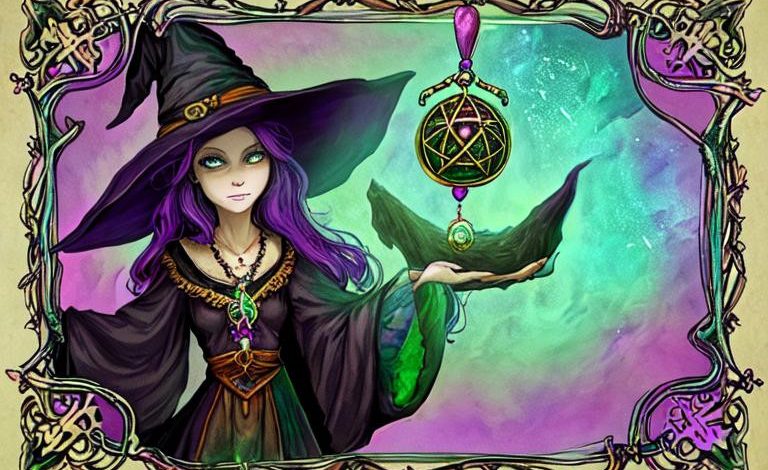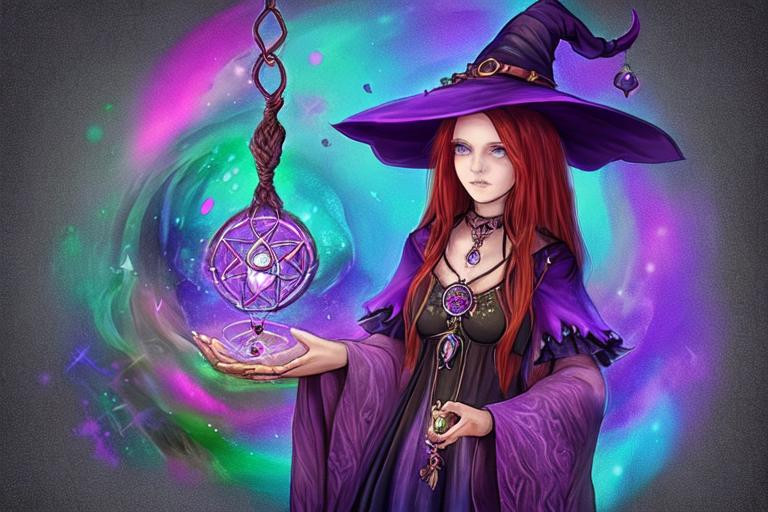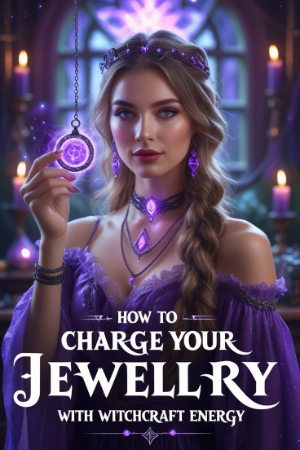
Amulets and magic have been a part of human culture for centuries. The use of amulets as protective talismans and symbols of power and strength dates back to ancient civilizations. These objects, imbued with mystical properties and potent energy, are often used as a means of invoking luck, warding off evil spirits, or bringing good fortune. In this article, we’ll explore the fascinating world of amulets and magic, and how these powerful tools can help us harness our inner witch.
The history of amulets is rich and varied, with different cultures using different objects for different purposes. In ancient Egypt, amulets were often fashioned in the shape of sacred animals or symbols, and were believed to hold the power of the gods. The Eye of Horus, for example, was a popular amulet that represented protection and healing. In Greek mythology, amulets were often associated with the gods and goddesses, and were used to invoke their protection and blessings.
Throughout history, amulets have been used for a variety of purposes, from protection and healing to fertility and love. One of the most common types of amulets is the talisman, a small object that is worn or carried on the body for protection or good luck. Talismans can be made from a variety of materials, including crystals, metals, and natural substances like herbs and roots.
Crystal amulets are particularly popular among those who practice witchcraft, as each crystal has its own unique energy and properties. For example, amethyst is often used for protection and psychic awareness, while rose quartz is used for love and emotional healing. Black tourmaline is another popular crystal for protection, as it is believed to absorb negative energy and transmute it into positive energy.
In addition to crystals, amulets can also be made from other natural substances, such as herbs and roots. For example, the herb sage is often used for purification and cleansing, while the root of the mandrake plant is believed to possess powerful magical properties. Some witches even create their own amulets by combining different herbs and crystals together in a small bag or pouch.
Amulets can also be used in spellwork, as they are believed to enhance the energy and intention of the spell. For example, if you were performing a spell for protection, you might incorporate a black tourmaline amulet into the spell to amplify its power. Similarly, if you were performing a spell for love, you might use a rose quartz amulet to enhance the energy of the spell.
In addition to their use in spellwork, amulets can also be used in divination and meditation. Many witches use amulets as a focal point for their meditation practice, as they help to anchor the mind and connect with the energy of the object. Some amulets, such as crystal pendulums, can also be used for divination, as they can help to access the wisdom of the universe and gain insight into the future.
Of course, the use of amulets and magic is not without controversy. Some people believe that the use of amulets and other magical objects is a form of superstition, and that there is no real scientific evidence to support their effectiveness. Others believe that the use of amulets and magic is a deeply personal and spiritual practice, and that the energy and intention behind the object is what gives it power.
Regardless of whether you believe in the power of amulets and magic, there is no denying their enduring appeal and their place in human history. From ancient Egypt to modern-day witchcraft, amulets have been used as a means of invoking the mystical and the unknown. So if you’re feeling a little witchy and want to explore the world of amulets and magic, there are a few key things you should keep in mind.
First and foremost, it’s important to choose an amulet that resonates with you on a personal level. Whether you’re drawn to the energy of a particular crystal, herb, or symbol, it’s important to trust your intuition and choose an amulet that feels right for you.
Once you have chosen your amulet, it’s important to cleanse and charge it before using it in your spellwork or meditation practice. This can be done by placing the amulet in direct sunlight or moonlight, or by smudging it with sage or palo santo.
When using your amulet in spellwork, it’s important to set a clear intention and focus your energy on the desired outcome. Whether you’re performing a spell for protection, love, or abundance, your amulet can help to amplify the energy and intention of your spell.
Finally, it’s important to remember that amulets and magic are just one tool in your spiritual toolkit. While they can be powerful tools for manifesting your desires and connecting with the divine, they should always be used in conjunction with other spiritual practices, such as meditation, journaling, and self-care.
Amulets and magic are a fascinating and deeply personal aspect of witchcraft and spirituality. Whether you’re drawn to the energy of crystals, herbs, or symbols, there is an amulet out there that can help you tap into your inner power and connect with the magic of the universe. So if you’re feeling a little witchy, don’t be afraid to explore the world of amulets and magic – who knows what kind of mystical wonders you might discover along the way.
The history of amulet making

The use of amulets dates back thousands of years, to ancient civilizations like the Egyptians, Greeks, and Romans. These early cultures believed that amulets possessed magical properties that could protect them from harm and bring good luck and prosperity.
In ancient Egypt, amulets were often made from precious stones and metals and were worn by both the living and the dead. The Egyptians believed that amulets could help guide the dead through the afterlife and protect them from evil spirits. Some of the most popular Egyptian amulets included the ankh, the Eye of Horus, and the scarab beetle.
In ancient Greece, amulets were used to protect against the evil eye and other negative energies. They were often made from materials like bone, glass, and precious metals, and were worn as necklaces, bracelets, and rings. The Greeks also believed in the power of engraved stones and symbols, and they would often carve protective symbols into amulets to enhance their power.
The Romans also believed in the power of amulets, and they used them for a variety of purposes, including protection, healing, and fertility. Roman amulets were often made from metals like gold and silver, and they were engraved with symbols like the bulla, a round amulet worn by children to protect them from harm.
In medieval Europe, amulets were used for both religious and secular purposes. Christians often wore amulets that featured images of saints or other religious figures, while peasants would wear amulets made from herbs and other natural materials to protect them from illness and harm.
During the Renaissance, amulet making became an art form, with artists and craftsmen creating intricate and beautiful amulets from precious metals and gems. These amulets were often personalized and customized for their owners, and they were believed to possess unique and powerful magical properties.
In modern times, amulet making has become a popular hobby and spiritual practice. People from all walks of life and spiritual traditions create and wear amulets for protection, healing, and personal growth. Amulet making workshops and classes are also popular, allowing people to learn the art of amulet making and create their own personalized amulets.
The history of amulet making is a rich and fascinating one, dating back thousands of years to ancient civilizations. Amulets have been used for a variety of purposes, from protection and healing to fertility and prosperity. Today, amulet making is still a popular practice, and people from all over the world continue to create and wear amulets for spiritual and personal reasons.
Types of amulets

Amulets are objects that are believed to possess magical or protective powers. Throughout history, people have used various types of amulets for different purposes, from warding off evil spirits to attracting love and prosperity. In this section, we’ll explore some of the most common types of amulets used in witchcraft and spirituality.
Crystal amulets
Crystal amulets are perhaps the most popular type of amulet used in modern witchcraft. Crystals are believed to possess unique energetic properties that can help to balance and heal the body, mind, and spirit. Some common crystal amulets include:
Clear quartz: A versatile crystal that is believed to amplify energy and intention, clear quartz is often used to enhance psychic abilities, attract prosperity, and promote clarity and focus.
Rose quartz: Known as the stone of love, rose quartz is believed to promote self-love, compassion, and romantic love. It’s often used in love spells and rituals, as well as for emotional healing.
Amethyst: A powerful crystal that is believed to enhance intuition, spiritual awareness, and psychic abilities. Amethyst is often used for meditation, stress relief, and protection against negative energies.
Black tourmaline: A protective crystal that is believed to absorb negative energy and electromagnetic radiation. Black tourmaline is often used for grounding, protection, and dispelling negative thoughts and emotions.
Herbal amulets
Herbal amulets are another popular type of amulet used in witchcraft. Herbs have been used for their healing and magical properties for thousands of years, and they are often incorporated into amulets and other magical tools. Some common herbal amulets include:
Mojo bags: A small bag filled with herbs, crystals, and other magical items, mojo bags are often used for protection, love, and abundance. The contents of the bag are chosen based on their energetic properties and the desired outcome.
Anointing oils: Anointing oils are oils infused with herbs and other magical ingredients, and they are often used to anoint candles, amulets, and other magical tools. Different oils are used for different purposes, such as attracting love, prosperity, or protection.
Sachets: A sachet is a small bag filled with herbs or other fragrant materials, such as lavender or rose petals. Sachets are often used for protection, purification, and attracting love and abundance.
Sigil amulets
Sigils are symbols that are charged with intention and used in spellwork and magic. They are often used in amulets and other magical tools to amplify the energy and intention of the spell. Some common sigil amulets include:
The pentagram: A five-pointed star that represents the elements of earth, air, fire, water, and spirit. The pentagram is often used for protection and invoking elemental energies.
The triple moon: A symbol that represents the phases of the moon (waxing, full, and waning) and the three aspects of the goddess (maiden, mother, and crone). The triple moon is often used in spells and rituals related to the moon and the goddess.
The infinity symbol: A symbol that represents infinite possibility and potential. The infinity symbol is often used in spells and rituals related to manifestation, abundance, and attracting positive energy.
Symbolic amulets
Symbolic amulets are objects that are believed to possess protective or magical powers due to their symbolic meaning. Some common symbolic amulets include:
The hamsa hand: A hand-shaped symbol that is believed to ward off the evil eye and protect against negative energy. The hamsa hand is often used as a necklace or bracelet, and it’s a popular amulet in Middle Eastern and Jewish culture.
The evil eye: The evil eye is a symbol that is believed to protect against the malevolent gaze of others. It’s often depicted as a blue or green eye, and it’s a popular amulet in Mediterranean and Middle Eastern culture.
The cross: The cross is a symbol that represents faith and protection. It’s often used as an amulet in Christian culture, and it’s believed to protect against evil and negative energies.
Talisman amulets
Talismans are objects that are believed to possess specific magical properties or powers. They are often used to attract a particular outcome, such as love, money, or protection. Some common talisman amulets include:
The horseshoe: A horseshoe is often used as a talisman for good luck and protection. It’s believed to ward off negative energies and attract positive ones.
The four-leaf clover: A four-leaf clover is a talisman for luck and abundance. It’s believed to attract good fortune and prosperity.
The rune stone: Rune stones are inscribed with ancient symbols that are believed to possess magical properties. Different rune stones are used for different purposes, such as protection, healing, and divination.
Animal amulets
Animal amulets are objects that are shaped like animals or feature animal symbols. Animals have long been associated with different energies and powers, and they are often used as amulets in witchcraft and spirituality. Some common animal amulets include:
The cat: Cats are often used as amulets for protection, luck, and psychic ability. They are believed to be able to see beyond the veil and protect their human companions from negative energies.
The snake: Snakes are often used as amulets for transformation, healing, and spiritual growth. They are associated with the energy of the earth and the cycle of life, death, and rebirth.
The owl: Owls are often used as amulets for wisdom, intuition, and psychic ability. They are associated with the energy of the moon and the goddess, and they are believed to be able to see through deception and illusion.
Amulets have been used for thousands of years in different cultures and spiritual practices. From crystals and herbs to sigils and symbolic objects, amulets come in various forms and have different properties and purposes. Whether you are seeking protection, love, abundance, or spiritual growth, there is likely an amulet that can help you on your journey.
Creating your own amulet

Creating your own amulet is a powerful way to connect with your spirituality and to create a physical symbol of your intentions and desires. Whether you want to create an amulet for protection, healing, or personal growth, the process can be both fun and rewarding.
Here are some steps to help you create your own amulet:
Choose your intention: Before you begin creating your amulet, take some time to think about what you want to accomplish with it. Do you want to create an amulet for protection, healing, love, or prosperity? Choose an intention that resonates with you and that you feel passionate about.
Choose your materials: Once you have your intention in mind, you can start choosing your materials. Amulets can be made from a variety of materials, including crystals, herbs, metals, and other natural materials. Choose materials that resonate with your intention and that have properties that align with your goal.
Cleanse your materials: Before you start creating your amulet, it’s important to cleanse your materials. This can be done by smudging with sage or palo santo, burying them in salt or earth, or placing them in sunlight or moonlight.
Assemble your materials: Once your materials are cleansed, you can begin assembling them into your amulet. You can use a piece of jewelry, such as a necklace or bracelet, or create a small pouch to hold your materials.
Charge your amulet: Once your amulet is assembled, it’s important to charge it with your intention and energy. You can do this by holding your amulet in your hands and visualizing your intention coming to life. You can also recite a prayer or affirmation to infuse your amulet with your energy.
Wear or carry your amulet: Once your amulet is charged, you can wear or carry it with you to help manifest your intention. You can also place it on your altar or in a special place in your home to help amplify its power.
Here are some ideas for creating different types of amulets:
Protection amulet:
For a protection amulet, you can use materials like black tourmaline, obsidian, or hematite, which are believed to have protective properties. You can also use symbols like the pentagram or the evil eye to help ward off negative energy.
Healing amulet:
For a healing amulet, you can use materials like rose quartz, amethyst, or citrine, which are believed to have healing properties. You can also include herbs like lavender or chamomile, which are associated with relaxation and calm.
Love amulet:
For a love amulet, you can use materials like rose quartz, garnet, or emerald, which are associated with love and romance. You can also include symbols like the heart or the infinity symbol to represent eternal love.
Prosperity amulet:
For a prosperity amulet, you can use materials like citrine, green aventurine, or pyrite, which are associated with abundance and prosperity. You can also include symbols like the dollar sign or the four-leaf clover to represent financial success.
Creating your own amulet is a powerful way to connect with your spirituality and to manifest your intentions and desires. With some intention, creativity, and a few simple materials, you can create a physical symbol of your goals and dreams that can help you stay focused and motivated. So go ahead and create your own magical amulet today!
The power of symbolism

Symbolism is the use of symbols to represent ideas or concepts. In the context of amulets and magic, symbols are often used to amplify the power of an amulet and to help focus the intention of the wearer.
The power of symbolism lies in its ability to communicate complex ideas and emotions through simple, recognizable imagery. Symbols can be cultural, religious, or personal, and they can have different meanings depending on the context in which they are used.
In amulet making, symbols are often used to represent certain qualities or energies that the wearer wants to manifest. For example, the pentagram is a symbol often used in protection amulets because it is associated with the elements and the power of nature. Similarly, the symbol of the infinity loop is often used in love amulets because it represents the eternal nature of love.
Symbols can also be used to help the wearer connect with a specific deity or spiritual entity. For example, the ankh is an ancient Egyptian symbol that represents eternal life and is often used in amulets dedicated to the goddess Isis. Similarly, the cross is a symbol often used in Christian amulets to represent the power of Christ.
The use of symbols in amulet making can also be a way to tap into the collective unconscious and to connect with archetypal energies. For example, the symbol of the moon is often used in amulets to represent feminine energy and intuition. The sun is often used to represent masculine energy and vitality.
Symbols can also be used to help the wearer connect with their own personal power and potential. For example, the lotus flower is a symbol often used in amulets to represent spiritual growth and the unfolding of one’s inner potential. The butterfly is a symbol often used in amulets to represent transformation and rebirth.
The power of symbolism lies in its ability to communicate complex ideas and emotions through simple, recognizable imagery. Symbols can help the wearer connect with their own personal power, tap into archetypal energies, and connect with spiritual entities.
When creating an amulet, it’s important to choose symbols that resonate with your intention and that have personal meaning to you. You can also create your own symbols or adapt existing symbols to fit your needs.
The power of symbolism is a potent tool in amulet making and magic. By choosing symbols that resonate with your intention and that have personal meaning to you, you can create amulets that are powerful, meaningful, and effective in manifesting your desires. So go ahead and explore the world of symbols, and see what magic you can create!
Using amulets in everyday life

Amulets are powerful tools that can be used in everyday life to protect, empower, and manifest. Here are some ways that you can incorporate amulets into your daily routine:
Wear your amulet: The easiest way to use an amulet is to wear it as jewelry. Whether it’s a necklace, bracelet, or ring, wearing your amulet close to your body can help you to stay focused on your intention and can act as a constant reminder of your goals.
Carry your amulet: If you don’t want to wear your amulet, you can carry it with you in your pocket, purse, or backpack. This can be especially useful if you are traveling or going through a stressful situation and need extra protection or support.
Place your amulet in your home or workspace: Amulets can also be placed in your home or workspace to help create a protective or empowering environment. For example, a protection amulet can be hung over the entrance of your home or placed on your desk at work to help ward off negative energy.
Use your amulet in meditation: Amulets can also be used in meditation to help you focus your intention and connect with your inner power. You can hold your amulet in your hand or place it on your third eye chakra (between your eyebrows) to help amplify its energy.
Incorporate your amulet into your self-care routine: Amulets can also be used in self-care rituals to help you connect with your body, mind, and spirit. For example, you can hold your amulet in your hand while taking a bath or use it in a visualization exercise to help you connect with your inner power.
Give an amulet as a gift: Amulets can also be given as gifts to friends and loved ones. Choose an amulet that resonates with their intention or that represents a special meaning or moment in your relationship.
When using amulets in everyday life, it’s important to remember that their power comes from your intention and belief in their ability to help you manifest your desires. Be clear about your intention and choose an amulet that resonates with your goals and personal style.
It’s also important to take care of your amulet by cleansing it regularly and keeping it in a safe place when not in use. You can cleanse your amulet by holding it under running water, smudging it with sage or palo santo, or leaving it in the moonlight overnight.
Amulets can be a powerful and practical tool for anyone seeking to protect, empower, and manifest in their everyday life. By incorporating amulets into your daily routine, you can stay focused on your intention and create a more positive and empowering environment for yourself and those around you. So go ahead and choose an amulet that resonates with you, and see what magic you can create in your life!
Final Musings
As witches, we understand the power of intention and the magic that can be created when we connect with our inner power and the natural world around us. Amulets are just one of the many tools that we can use to help us tap into this power and manifest our desires.
By using amulets in our everyday life, we can create a deeper connection with our intention and the energy that surrounds us. We can use amulets to protect ourselves from negative energy, to empower ourselves to achieve our goals, and to manifest the life that we desire.
But it’s important to remember that the true power of amulets lies not in the physical object itself, but in our belief in their ability to help us manifest our desires. As witches, we know that our thoughts and beliefs have the power to shape our reality. When we focus our intention on our amulet and believe in its ability to help us manifest our desires, we tap into the true power of magic.
So as you explore the world of amulets and magic, remember to keep an open mind and trust in your own inner power. Choose amulets that resonate with your intention and personal style, and use them in ways that feel authentic and meaningful to you. And most importantly, trust in your ability to create the magic that you seek.
As a final reminder, always remember to honor the natural world and the energies that surround us. Use your amulets with respect and gratitude, and never forget the power of the magic that you create. May your amulets serve as a powerful tool on your journey of self-discovery, manifestation, and magic. Blessed be.




